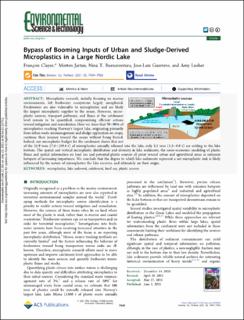| dc.contributor.author | Clayer, Francois | |
| dc.contributor.author | Jartun, Morten | |
| dc.contributor.author | Buenaventura, Nina T | |
| dc.contributor.author | Guerrero, Jose-Luis | |
| dc.contributor.author | Lusher, Amy | |
| dc.date.accessioned | 2021-09-01T13:07:16Z | |
| dc.date.available | 2021-09-01T13:07:16Z | |
| dc.date.created | 2021-07-22T09:30:40Z | |
| dc.date.issued | 2021 | |
| dc.identifier.citation | Environmental Science and Technology. 2021, 55 (12), 7949-7958. | en_US |
| dc.identifier.issn | 0013-936X | |
| dc.identifier.uri | https://hdl.handle.net/11250/2772283 | |
| dc.description.abstract | Microplastic research, initially focusing on marine environments, left freshwater ecosystems largely unexplored. Freshwaters are also vulnerable to microplastics and are likely the largest microplastic supplier to the ocean. However, microplastic sources, transport pathways, and fluxes at the catchment level remain to be quantified, compromising efficient actions toward mitigation and remediation. Here we show that 70–90% of microplastics reaching Norway’s largest lake, originating primarily from urban waste mismanagement and sludge application on crops, continue their journey toward the ocean without being buried. Indeed, our microplastic budget for the catchment shows that out of the 35.9 tons (7.4–119.4 t) of microplastics annually released into the lake, only 3.5 tons (1.3–8.8 t) are settling to the lake bottom. The spatial and vertical microplastic distribution and diversity in lake sediments, the socio-economic modeling of plastic fluxes and spatial information on land use and potential plastic sources all point toward urban and agricultural areas as emission hotspots of increasing importance. We conclude that the degree to which lake sediments represent a net microplastic sink is likely influenced by the nature of microplastics the lake receives, and ultimately on their origin. | en_US |
| dc.language.iso | eng | en_US |
| dc.publisher | American Chemical Society | en_US |
| dc.rights | Navngivelse 4.0 Internasjonal | * |
| dc.rights.uri | http://creativecommons.org/licenses/by/4.0/deed.no | * |
| dc.title | Bypass of Booming Inputs of Urban and Sludge-Derived Microplastics in a Large Nordic Lake | en_US |
| dc.type | Peer reviewed | en_US |
| dc.type | Journal article | en_US |
| dc.description.version | publishedVersion | en_US |
| dc.rights.holder | © 2021 The Authors. | en_US |
| dc.source.pagenumber | 7949-7958 | en_US |
| dc.source.volume | 55 | en_US |
| dc.source.journal | Environmental Science and Technology | en_US |
| dc.source.issue | 12 | en_US |
| dc.identifier.doi | 10.1021/acs.est.0c08443 | |
| dc.identifier.cristin | 1922388 | |
| cristin.ispublished | true | |
| cristin.fulltext | original | |
| cristin.qualitycode | 2 | |

